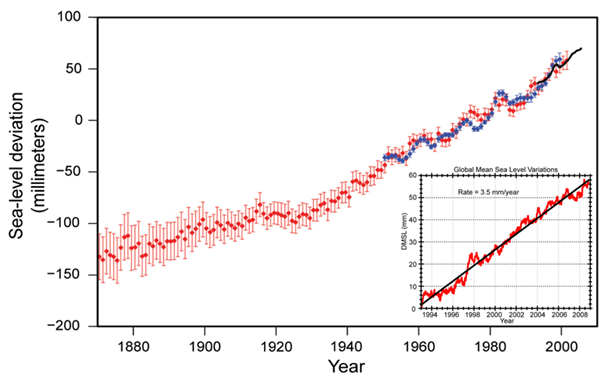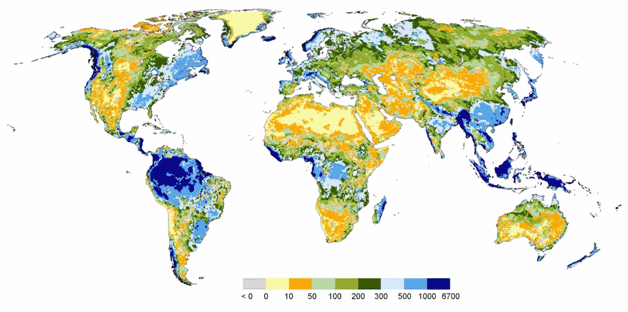The quote at the beginning of this lesson is an unfortunate representation of freshwater management in the present. There are enough freshwater resources globally to support human populations; however, allocating the water to at-risk populations is where freshwater scarcity comes into play. A key example of this quote can be seen in the map below (Figure 11.1). Nations like Norway have enormous water resources that could support a population much larger than itself, while nations like Yemen on the Southern Arabian Peninsula have hardly enough freshwater to support their population.
The changing global climate is expected to greatly impact available water resources. According to NOAA, “Records and research show that sea level has been steadily rising at a rate of 1 to 2.5 millimeters (0.04 to 0.1 inches) per year since 1900. This rate may be increasing. Since 1992, new methods of satellite altimetry (the measurement of elevation or altitude) indicate a rate of rise of 3 millimeters (0.12 inches) per year” (Figure 11.2). If the rate of 3 mm (0.12 inches) per year remains steady, it is possible that by 2100 the ocean will be at a height of 300 mm (12 inches) or one foot higher than it was in 2000. If the ocean were a foot higher in elevation, many island nations throughout the world would be forced to abandon their homeland and become environmental refugees in foreign nations. Coastal cities throughout the world would have to spend billions of dollars to prevent the ocean from encroaching on their boundaries.

At this rate of 3 mm (0.12 inches) per year of increased elevation, human populations should be concerned. As global temperatures rise, places like Greenland, which have trillions of gallons of freshwater stored in ice and glaciers, will begin to experience a decrease in the mass of their snow cover as they melt, adding to the rising sea elevation. Besides the expanding ocean taking away valuable land where humans live upon, it can also have other devastating impacts. Storm surges or even high tides would be capable of bringing the saline ocean water into rivers, groundwater, and reservoirs as the ocean expands. These freshwater resources will mix ocean water with freshwater, creating brackish, undrinkable water. Changing climate also will have an impact on freshwater resources. Larger fluctuations in rainfall will result in longer periods of drought, which could drain groundwater and riverine resources. Rainfall fluctuations will also cause stronger floods and storms, which could cause increased saltwater intrusion and pollution of freshwater resources.
Population growth is expected to increase in the coming century with global populations reaching nearly 8.1 billion by 2025, 9 billion by 2050, and nearly 11 billion people by the century's end. Such a rapidly increased global population is expected to place additional stress on freshwater resources. Peoples from water-stressed regions of the world will become environmental refugees. They will be forced to migrate to countries that possess an excess of freshwater, most likely places like the United States or North/Central Europe. In order to protect remaining freshwater resources in the face of decreasing land space and a rapidly increasing global population, effective conservation policies must be developed.
